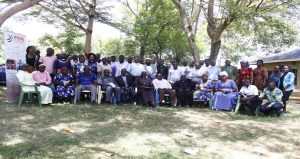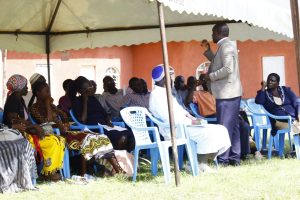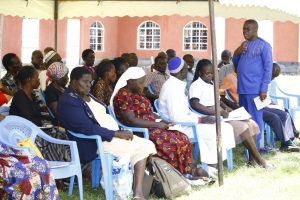Using ISJA tool to address SRHR issues within religious spaces.
 16 May 2024
16 May 2024
On March 19th and 21st March 2024, IFAGE, in collaboration with The Circle of Concerned African Women Theologians, conducted a lobbying and advocacy activity using the ISJA tool to address sexual and reproductive health and rights (SRHR) issues within religious spaces.
On March 19th and 21st March 2024, IFAGE, in collaboration with The Circle of Concerned African Women Theologians, conducted a lobbying and advocacy activity using the ISJA tool to address sexual and reproductive health and rights (SRHR) issues within religious spaces. The objectives of the activity were to explore the intersections between religious teachings and youth SRHR issues, identify barriers and opportunities for faith-based advocacy initiatives, and develop actionable strategies for promoting youth-friendly SRHR services and education within religious settings.
The activity took place in Usenge and Saradidi, Bondo Sub-County. Participants included representatives of religious leaders from various denominations, namely the Anglican Church of Kenya, Seventh Day Adventist, African Independent Church, Catholic Church, Muslims, Nomiya Luo, Legio Maria, Chrisco, Roho, God’s Last Appeal, Baptisms, Redeemed Gospel, Injili, Holy Apostolic, Pentecostal, Roho Israel, Jerusalem Assembly Church, Nazarene, Roho Fweny, Revival Promised Church, Saviour and Healing, and Baptism.
The religious leaders’ dialogue activity aimed to foster understanding, collaboration, and support for youth sexual and reproductive health and rights advocacy initiatives within faith-based contexts. Utilizing the “See, Judge, and Act” framework, participants delved into a deeper understanding of SRHR challenges, analyzed their implications within faith contexts, and strategized effective actions.

Religious leaders from various denominations in Saradidi posing for a photo during the activity.
During the two activities, participants engaged in fruitful discussions focusing on several key discussion points:
Compatibility of religious teachings with contemporary SRHR Issues:
Participants discussed the compatibility of religious teachings with sexual and reproductive health and rights issues.
Understanding SRHR needs and healing Spaces:
A presentation was conducted on the diverse SRHR needs of adolescents and youths, highlighting the importance of establishing safe and healing spaces where young people can feel supported and empowered.
Impact of cultural and religious barriers on mental and emotional well-being:
Discussions were held on the effects of cultural and religious barriers on the mental and emotional well-being of young people seeking SRHR services.
Recognition of stigma, discrimination, and lack of Acceptance:
Stigma, discrimination, and lack of acceptance were acknowledged as significant barriers to accessing support and services.
Addressing challenges and Opportunities for Faith-Based Advocacy:
Challenges such as stigma, misinformation, and cultural barriers were addressed, along with opportunities for faith-based advocacy.
Development of strategies:
Strategies were formulated for integrating SRHR education and services into religious programming while respecting diverse beliefs.
Acknowledgment of Differing Beliefs and Values:
The challenges posed by differing beliefs and values were recognized, with participants emphasizing the importance of respectful dialogue and mutual understanding. Solutions included promoting interfaith cooperation and addressing misconceptions through education and awareness campaigns.
The achievements stemming from the two activities were notable as follows:
Firstly, religious leaders openly exchanged perspectives on the concept of healing spaces within the framework of their respective faith traditions.
Secondly, discussions centered on discovering common ground among religious leaders to advance the well-being of adolescents and youths.
Thirdly, there was a significant emphasis on the shared values of compassion, justice, and dignity, which served as foundational principles for creating inclusive spaces.
Additionally, the facilitators thoughtfully allocated specific time slots in the agenda for youth-led sessions. These sessions provided a platform for young people to directly share their perspectives, experiences, and recommendations with religious leaders.
Lastly, actionable steps were developed to implement initiatives aimed at promoting safe and healing spaces for young people, thereby ensuring tangible progress towards addressing their needs and fostering their overall well-being.

Reverend Dominic Misolo presenting to the participants during the activity in Usenge.
Challenges and Lessons Learned.
Challenges
Resistance and opposition: Some religious leaders may have resisted discussing SRHR issues due to religious beliefs or cultural norms, hindering open dialogue and collaboration.
Misunderstandings and misinterpretations: Misunderstandings of religious teachings regarding SRHR topics during discussions led to challenges in communication and understanding.
Generational and cultural differences: Varied perspectives on SRHR advocacy between youths and religious leaders, stemming from generational and cultural disparities, made finding common ground difficult.
Lack of Trust and preconceptions: Preconceived notions and lack of trust among stakeholders, including youths and religious leaders, hindered effective communication and collaboration.
Limited engagement and participation: Ensuring active engagement and participation from all stakeholders, especially youths and religious leaders, proved challenging due to competing priorities or lack of interest.
Lessons Learned:
Youth leadership and empowerment: Empowering youths to take leadership roles and participate actively in dialogues enables them to contribute meaningfully and advocate for their rights.
Flexibility and adaptability: Adopting a flexible approach in addressing challenges allow for constructive problem-solving and finding common ground in SRHR advocacy goals.
Continued engagement and collaboration: Sustaining engagement and collaboration through ongoing communication, partnerships, and follow-up actions were crucial for driving long-term impact and positive change in SRHR policies and practices.
Building trust and rapport: Prioritizing relationship-building and creating a supportive and inclusive environment are key to fostering trust and rapport among diverse stakeholders.
Effective communication strategies: Employing effective communication strategies, such as active listening, empathy, and cultural sensitivity, helps bridge communication gaps and facilitate constructive dialogue.
Education and awareness: Providing opportunities for education and awareness-raising on SRHR issues, including religious perspectives, helps address misconceptions and fosters greater understanding among participants.
Action Plans
The religious leaders developed and agreed upon the following action plans for implementation:
Emphasize Teenage Challenges in Bondo Sub County:
- Address issues such as gender-based violence (GBV), early pregnancies, marriages, and HIV/AIDS from the pulpit.
Incorporate SRHR topics in church conferences:
- Include discussions on sexual and reproductive health and rights (SRHR) during church conferences targeting young people.
Initiate community studies with scriptural interpretations:
- Conduct community studies integrating scriptures to interpret and teach SRHR concepts.
Engage departmental groups:
- Collaborate with departmental groups such as the Kenya Anglican Men’s Association, Kenya Anglican Youth Organization, and Mothers’ Union to raise awareness about SRHR issues.
Integrate SRHR Talks in school pastoral meetings:
-
- Incorporate discussions on SRHR topics during pastoral meetings in primary and secondary schools.
Provide Age-Appropriate sex education:
- Offer age-appropriate sex and sexuality education sessions within the church community.
Introduce SRH topics to church members:
- Introduce SRHR topics to the church community through various means such as mobilization sessions in villages and discussions during sports activities.
Collaborate with ministry of health:
- Partner with the Ministry of Health to ensure that the SRHR needs of youths were appropriately addressed.
Adapt and provide advice to youth:
- Accept, adjust, and offer guidance to youths based on their context and age.
Advocate within church leadership:
Share SRHR messages with church leaders and departments to raise awareness and promote understanding.
Invite experts for youth education:
- Invite experts to conduct sessions on SRHR issues targeting youths within church settings.
Create awareness within faith spaces:
- Raise awareness about SRHR within faith spaces through various initiatives.
Educate church members:
- Educate other church members about SRHR topics and their importance.
Incorporate SRH teaching in sermons:
-
- Integrate SRHR teachings into sermons to reach a wider audience.
Utilize church departments for advocacy:
- Utilize different church departments to advocate for SRHR issues effectively.
Include SRH Topics in Madrasa classes:
- Incorporate SRHR topics into existing madrasa classes for the muslims.
Collaborate with IFAGE and The Circle for outreach:
- Work closely with IFAGE and The Circle to disseminate SRHR information to youths within church spaces.

Evans Nyesi, facilitating on ISJA during the session.



